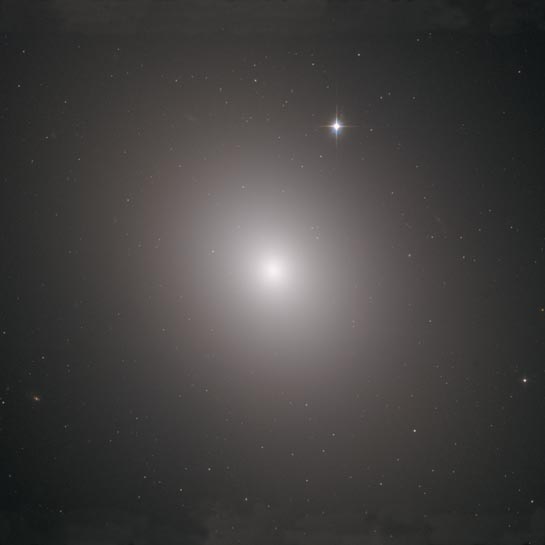
Elliptical Galaxy
RA 12h 29m 46.74s Dec 8° 0' 1.88"
Virgo
56 million light years
8.4
11.5 × 8.5 arcmin
3.10 x 2.57 arcminutes
North is 114.7° right of vertical
ESA/Hubble & NASA, J. Blakenslee, P Cote et al.
March 18, 2019
ABOUT
THIS IMAGE:
This fuzzy orb of light is a giant elliptical galaxy filled with an incredible 200 billion stars. Unlike spiral galaxies, which have a well-defined structure and boast picturesque spiral arms, elliptical galaxies appear fairly smooth and featureless. This is likely why this galaxy, named Messier 49, was discovered by French astronomer Charles Messier in 1771. At a distance of 56 million light-years, and measuring 157 000 light-years across, M49 was the first member of the Virgo Cluster of galaxies to be discovered, and it is more luminous than any other galaxy at its distance or nearer.
Elliptical galaxies tend to contain a larger portion of older stars than spiral galaxies and also lack young blue stars. Messier 49 itself is very yellow, which indicates that the stars within it are mostly older and redder than the Sun. In fact, the last major episode of star formation was about six billion years ago - before the Sun was even born!
Messier 49 is also rich in globular clusters; it hosts about 6000, a number that dwarfs the 150 found in and around the Milky Way. On average, these clusters are 10 billion years old. Messier 49 is also known to host a supermassive black hole at its center with the mass of more than 500 million Suns, identifiable by the X-rays pouring out from the heart of the galaxy (as this Hubble image comprises infrared observations, these X-rays are not visible here).
From Wikipedia:
Messier 49 (also known as M 49 or NGC 4472) is an elliptical galaxy located about 56 million light-years away in the equatorial constellation of Virgo. This galaxy was discovered by French astronomer Charles Messier on February 16, 1777.
As an elliptical galaxy, Messier 49 has the physical form of a radio galaxy, but it only has the radio emission of a normal galaxy. From the detected radio emission, the core region has roughly 1053 erg (1046 J or 1022 YJ) of synchrotron energy. The nucleus of this galaxy is emitting X-rays, suggesting the likely presence of a supermassive black hole with an estimated mass of 5.65 × 108 solar masses, or 565 million times the mass of the Sun. X-ray emissions shows a structure to the north of Messier 49 that resembles a bow shock. To the southwest of the core, the luminous outline of the galaxy can be traced out to a distance of 260 kpc. The only supernova event observed within this galaxy is SN 1969Q, discovered in June 1969.
This galaxy has a large collection of globular clusters, estimated at about 5,900. By contrast, this count is far more than the roughly 200 orbiting the Milky Way, but is exceeded by the 13,450 globular clusters orbiting the supergiant elliptical galaxy Messier 87. On average, the globular clusters of M 49 are about 10 billion years old. Between 2000 and 2009, strong evidence for a stellar mass black hole was discovered in an M 49 cluster. A second candidate was announced in 2011.
Messier
49 was the first member of the Virgo Cluster of galaxies to be discovered.
It is the most luminous member of that cluster and more luminous than
any galaxy closer to the Earth. This galaxy forms part of the smaller
Virgo B subcluster located 4.5° away from the dynamic center of the
Virgo Cluster, centered on Messier 87. Messier 49 is gravitationally interacting
with the dwarf irregular galaxy UGC 7636. The dwarf shows a trail of debris
spanning roughly 1 × 5 arcminutes, which corresponds to a physical
dimension of 6 × 30 kpc.